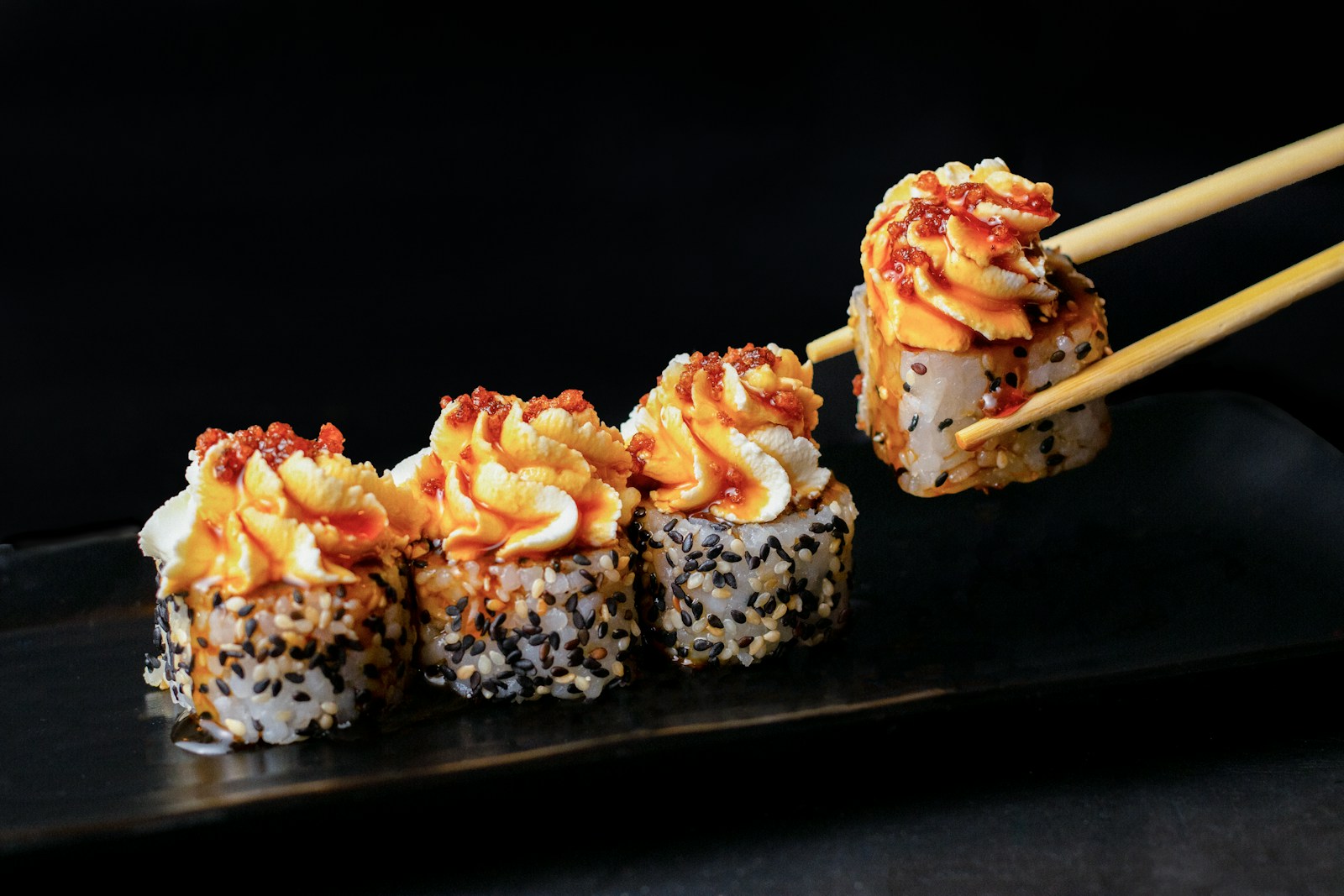Introduction
For many, the word “sushi” conjures up images of delicate, bite-sized morsels of rice topped with vibrantly colored fish or vegetables, neatly arranged on a platter. However, sushi is much more than a mere food item. It is a gastronomic experience, an edible art form that is steeped in tradition and culture. Revered in its native Japan and adored around the globe, sushi’s popularity in modern cuisine is unquestionable.
Underlying the widespread popularity of sushi is its deep cultural significance. Originating from Japan, sushi is not just a staple food but also a testament to the country’s historical reliance on seafood and rice. The art of sushi represents the essence of Japanese cuisine – simplicity, precision, and a profound respect for the ingredients. In this article, we aim to take you on a gastronomic journey through the rich tastes and textures of sushi, illuminating its art, history, and global influence.
The story of sushi is as fascinating and complex as its creation. It’s a culinary tale that spans centuries, reflecting an enduring commitment to technique and tradition. The evolution of sushi serves as a testament to the Japanese spirit of innovation and adaptation. From the original form of fermented fish and rice to the modern-day sushi that boasts a multitude of varieties like nigiri, maki, and sashimi, sushi’s journey is a testament to culinary evolution.
In the world of sushi, every ingredient matters, with the quality of each component directly impacting the final taste. Traditional sushi chefs invest significant time and effort in sourcing the freshest ingredients. Globalization has played a crucial role in this aspect, making it possible to source fresh fish from around the world, thereby enriching the sushi experience.
Connoisseurs of sushi understand that the creation of these culinary masterpieces requires precision and skill. Each step, from preparing the perfectly seasoned rice to slicing the fish, is meticulously executed. The art of sushi making is a dance of precision and passion, resulting in a harmonious blend of flavors and textures that delights the senses.
In addition to being a gastronomic delight, sushi is also a visual treat. The presentation of sushi is an integral part of the experience, with each piece arranged to showcase its aesthetic appeal. This aspect of sushi further elevates it from a meal to an art form.
As you embark on this journey, we invite you to explore the vibrant world of sushi, its origins, its adaptations, and its future. We hope this exploration encourages you to delve deeper into the art of sushi and appreciate the skill and passion that goes into its creation.
The History of Sushi
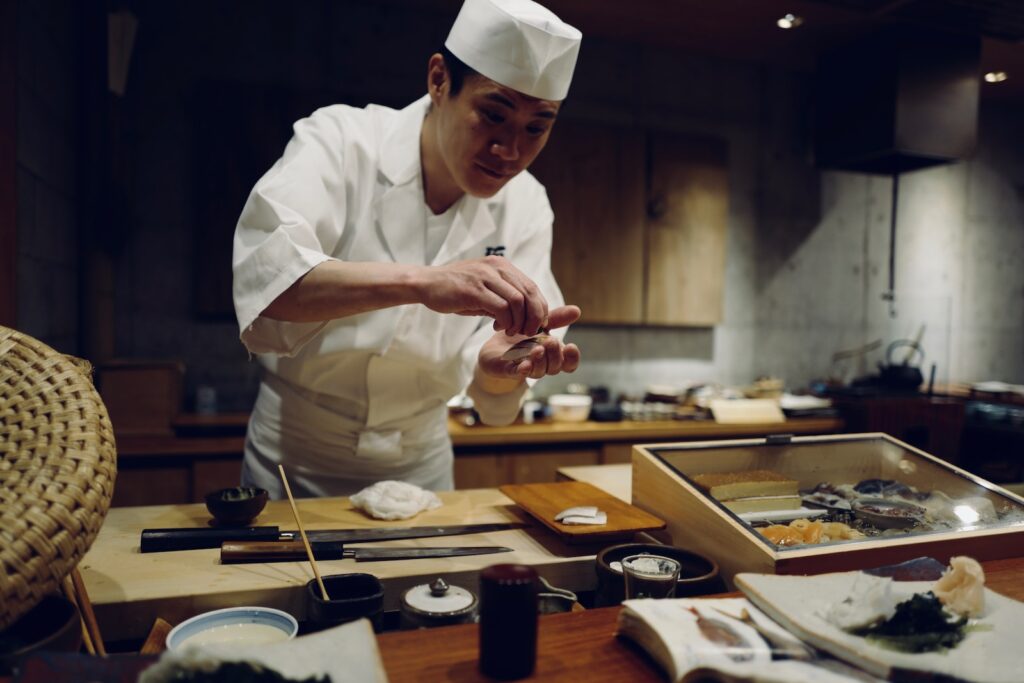
As the sun sets on the horizon, dipping below the skyline of skyscrapers, the fragrant smell of vinegar-soaked rice wafts through the maze-like streets of Tokyo. It’s a smell that’s overwhelmingly familiar – the rich scent of sushi, a culinary tradition steeped in history.
The tale of sushi began around the 8th century in Japan. It evolved from a method of preserving fish in fermented rice, a dish known as nare-zushi. The cooked rice was used to ferment the fish, and after months of fermentation, the rice was discarded and only the fish was consumed.
It wasn’t until the 17th century that sushi took on the form we are familiar with today. A man named Hanaya Yohei revolutionized the dish by deciding to serve the fish and rice together, creating what is now known as Edo-style sushi.
Over the centuries, sushi has evolved and diversified into a variety of styles and presentations. Three types of sushi particularly stand out:
- Nigiri: A type of sushi where a slice of raw fish is pressed atop a ball of vinegared rice. Nigiri is a testament to the delicate balance and harmony that sushi strives for, combining the freshness of the fish with the subtle sweetness of the rice.
- Maki: Maki sushi is perhaps what most people envision when they hear the term ‘sushi.’ This type of sushi involves rolling rice and other ingredients in a sheet of seaweed using a bamboo mat, and then cutting it into bite-sized pieces.
- Sashimi: While not technically sushi as it doesn’t involve rice, sashimi is closely associated and often enjoyed alongside sushi. Sashimi is essentially thinly sliced raw fish, showcasing the purity and quality of the ingredients.
The ingredients used in sushi are a reflection of Japan’s culinary philosophy – simplicity and freshness. The traditional ingredients of sushi are few – vinegared rice, fresh fish, seaweed, and sometimes vegetables or fermented soybeans. However, the skill and precision required to balance these simple ingredients are what makes sushi a revered art form.
Today, the art of sushi making, or sushi-shoku, continues to be passed down from generation to generation, each new generation of sushi chefs adding their own flair and interpretation to this timeless cuisine. The evolution of sushi is a testament to the dynamism and resilience of Japanese culture, as it continues to adapt and thrive amidst changing times.
The Importance of Freshness
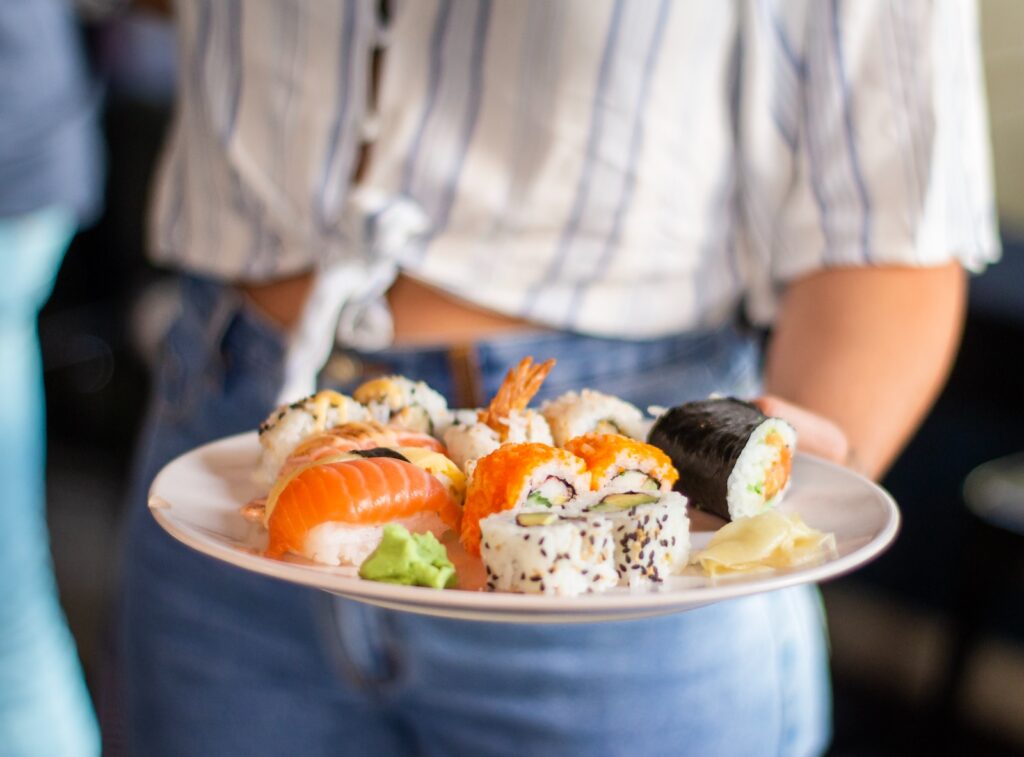
When diving into the world of sushi, one factor emerges as the culinary cornerstone of this artful cuisine: freshness. In the realm of sushi, freshness is not a luxury, but a necessity. The sushi experience is not merely a meal but a sensory journey, and nothing ensures a successful expedition like the quality and freshness of the ingredients used.
One might wonder, why is freshness so important in sushi? It all comes down to the raw, unadulterated nature of the sushi ingredients. Unlike other cuisines, where cooking can mask the imperfections of ingredients, sushi is often served raw. This leaves no room for mediocrity; only the freshest ingredients can deliver the tantalizing taste and harmony of flavors characteristic of sushi.
At the heart of fresh sushi is the seafood. In fact, sushi chefs are often more akin to hunters in their pursuit of the highest-quality ingredients. They select their fish with a discerning eye, often visiting the market daily to ensure they have the freshest catch. Each selection is made with regard to the species, season, and region.
But the journey doesn’t end there. Once procured, the delicate task of preparing the fish begins. The fish must be cleaned, and sometimes aged, with the utmost precision and care. This meticulous process is not just about preserving the freshness, but also enhancing the fish’s natural flavors.
And let’s not forget about the rice. Though often overlooked, sushi rice plays a crucial role in the overall flavor profile. It must be prepared with the right balance of vinegar, salt, and sugar, and must be served at the perfect temperature. In sushi, every component, no matter how small, plays a part in the symphony of taste.
But it’s not only about taste. Freshness also plays a role in the aesthetics of sushi. The vibrant colors of fresh fish against the stark white of sushi rice is a feast for the eyes before it even reaches your palate. The visual appeal of sushi is a testament to its freshness and quality.
The globalization of sushi has raised questions and challenges regarding the availability of fresh ingredients. With sushi restaurants popping up around the globe, the demand for fresh fish has soared. But despite these challenges, the importance of freshness remains at the heart of sushi making, ensuring that every bite is a testament to the artistry and dedication of the sushi chef.
So, next time you sit down for a sushi meal, take a moment to appreciate the freshness of your dish. Behind each piece lies a world of passion, precision, and a relentless pursuit of quality.
The Art of Sushi Making

Delving into the art of sushi making is akin to stepping into an intimate dance between a chef and raw ingredients. The process is a harmony of precision, patience, passion, and respect for the culinary tradition, resulting in bites of art that are as delightful to the eyes as they are to the palate.
- Preparing the Rice: Sushi’s backbone is sushi meshi or sushi rice. The rice selection is crucial, with sushi chefs typically leaning towards short or medium-grain rice varieties known for their sticky texture when cooked. The rice is rinsed multiple times to shed the excess starch and then cooked. Once done, a mixture of rice vinegar, sugar, and salt is uniformly mixed in, enhancing the flavor profile of the sushi rice. This vinegar-infused rice is left to cool at room temperature. The cooling process is vital as hot or warm rice would ruin the delicate raw fish.
- Slicing the Fish: The next step is preparing the protein, predominantly raw fish, although sushi can also include cooked fish, shellfish, and even vegetables. The art of sushi making truly shines here as the chef must showcase their skill in slicing the fish. Each slice should be thin and consistent, reflecting the chef’s mastery over the knife. One should remember that the thickness of the fish slice can drastically affect the overall taste experience.
There’s a unique beauty in the way sushi chefs handle their ingredients. Their hands move with a fluidity and grace that almost resembles a dance, a testament to their years of training and experience.
- Shaping the Sushi: The shaping of sushi is a test of a sushi chef’s skill and dexterity. The chef takes a small amount of vinegared rice, lays a slice of fish on top, and shapes them with a gentle press. The goal is to shape the sushi that it holds together when picked up but falls apart in the mouth, allowing the consumer to experience the full spectrum of texture and flavor.
- Adding the Finishing Touches: Finishing touches may include a brush of soy sauce, a sprinkle of toasted sesame seeds, or a thin slice of ripe, creamy avocado. These add an extra layer of flavor and visual appeal to the sushi.
One integral component in the art of sushi making that cannot be overlooked is presentation. The visual appeal of sushi plays a significant role in the dining experience. The sushi pieces are usually arranged beautifully on a minimalistic plate, often in combination with vibrant garnishes such as pickled ginger, wasabi, and a small heap of thinly sliced radish.
In conclusion, the art of sushi making is a delicate process that requires an understanding of balance, a keen eye for detail, and a refined skill set. It is a testament to the rich culinary tradition of Japan, a tradition that continues to evolve and inspire on a global scale.
Pairing Sushi with Sake
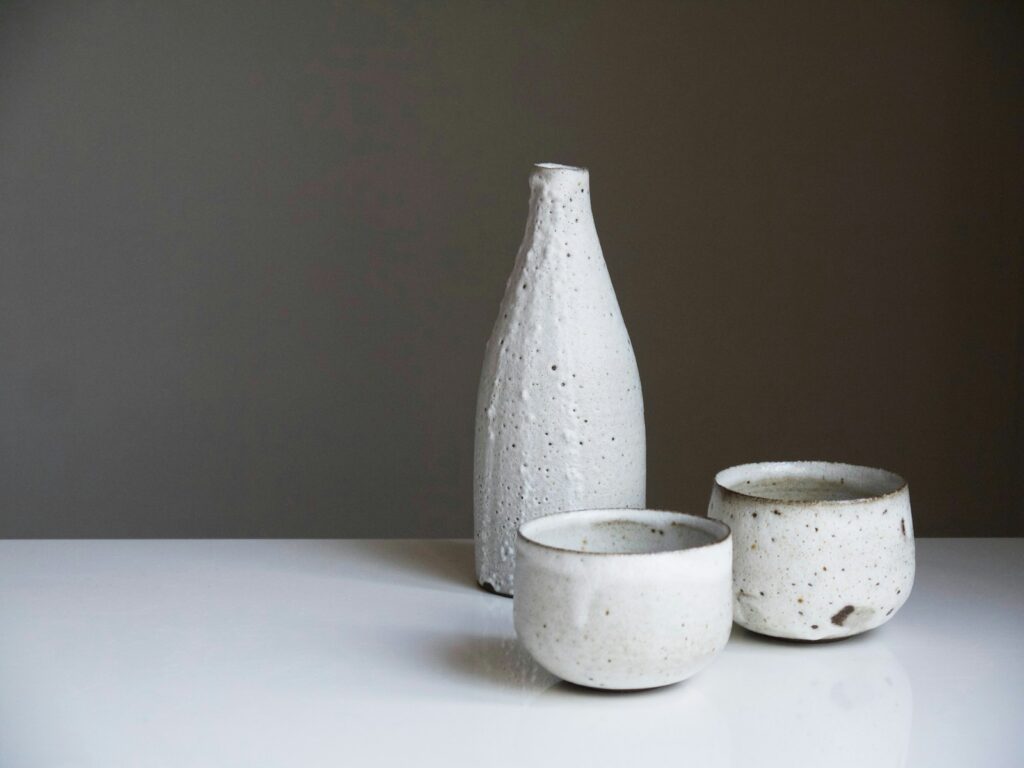
The traditional practice of pairing sushi with sake is more than just a gustatory delight, it’s an art form. This Japanese tradition is steeped in centuries of history and culture, and is considered an essential part of any truly authentic sushi dining experience. Understanding this pairing can not only enhance the flavor of the sushi, but can also provide a deeper appreciation for the craftsmanship and creativity that goes into each dish.
So, how does one go about pairing sushi with sake? In essence, it’s all about balance. The delicate, yet robust flavors of sushi should be complemented, not overpowered, by the sake. To achieve this harmonious combination, one must take into consideration several factors:
- The type of sake: There are many types of sake, ranging from sweet to dry, and each one has its own unique flavor profile. Generally, a crisp, dry sake might pair well with lighter fish like tuna or snapper, while a fuller-bodied, complex sake might be better suited to richer, fattier fish such as salmon or mackerel.
- The type of sushi: Like sake, sushi also varies greatly in its flavor and composition. Lighter sushi might call for a more delicate sake, while a spicier roll might require a sake with a bit more depth and complexity to counterbalance the heat.
- The temperature of the sake: Sake can be served either chilled, at room temperature, or warm, depending on the season and the type of sushi being served. Generally, lighter sakes are served chilled, while fuller-bodied ones are often served slightly warmed.
While these guidelines can be helpful, the most important thing is to trust your own palate. After all, the beauty of sushi and sake pairing lies in its ability to cater to individual tastes and preferences.
Along with the taste, the ritual of sake drinking also enhances the sushi dining experience. The serving of sake often involves traditional customs, including the use of specific types of ceramic or wooden cups, and a particular pouring etiquette. These nuances add a layer of sophistication and respect to the dining experience, reflecting the deep-rooted values of Japanese culture.
The global popularity of sushi has led to a renewed interest in sake, with artisan sake breweries popping up around the world. This has not only made sake more accessible to a global audience, but has also expanded the possibilities for sushi and sake pairing.
In conclusion, pairing sushi with sake is an art that requires a delicate balance of flavors and a respect for tradition. By exploring different combinations, one can embark on a unique, gastronomic journey, enriching their sushi dining experience and expanding their culinary horizons.
Sushi Around the World
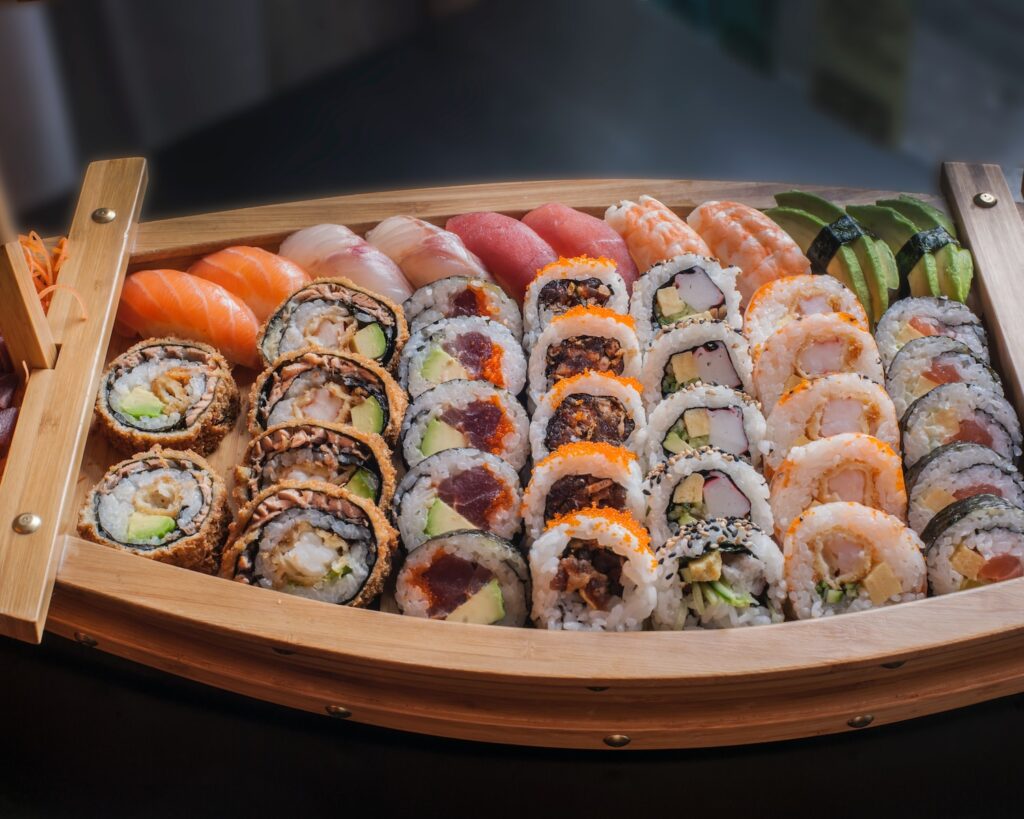
Like a delicate brushstroke on a vast canvas, sushi has painted its vibrant palette of flavors, textures, and aesthetics across the global gastronomic landscape. Originating in Japan, this culinary art form has been enthusiastically embraced worldwide, evolving into diverse forms that showcase cultural fusion at its best. While it is a testament to sushi’s universal appeal, it has not been without its share of controversies.
The journey of sushi from Japan to the world began with its introduction to the United States in the late 20th century. The ubiquitous California roll, with its avocado and crab filling encased in rice and seaweed, marked a significant adaptation of sushi to cater to Western palates. This was sushi’s first major global transformation.
- Nigiri, the traditional sushi form, was replaced by the inside-out roll, a creative twist with the rice on the outside. It blurred the lines between traditional and modern, setting the stage for sushi’s global adaptations.
- In Brazil, the influence of the large Japanese-Brazilian population led to the creation of temaki, a hand-rolled cone of sushi that innovatively incorporates local ingredients like cream cheese and mango.
- Europe, too, has embraced sushi with open arms. In Scandinavia, the Swedish sushi or “sushisallad” is a deconstructed version of sushi with all its elements tossed together in a salad.
However, as sushi ventured out of Japan, its authenticity came under scrutiny. The fusion of flavors and techniques that cater to local tastes have often been criticized by purists who argue that it dilutes the traditional essence of sushi. The debate over what constitutes ‘real sushi’ continues, reflecting the tension between tradition and innovation in the food culture.
Despite the controversies, the global adaptations of sushi underline its versatility and universal appeal. These creative variations have not only expanded sushi’s fan base but also signified the democratization of a cuisine that was once reserved for the elite in Japan. The explosion of sushi bars and restaurants around the world, serving everything from budget sushi rolls to high-end omakase, attests to its global popularity.
Over the years, sushi has transcended its traditional confines, assimilating into various food cultures and morphing into myriad forms. From the Californian roll to the Brazilian temaki, sushi’s journey around the world is a testament to its resilience, adaptability, and unending charm. As it continues to evolve, the art of sushi promises a gastronomic journey that is as diverse as it is delicious.
The Dining Experience

Feasting on sushi is about much more than just satisfying your gastronomic cravings. It’s a multi-sensory affair that goes beyond the taste buds, engaging all your senses. From the meticulously arranged sushi on your plate to the minimalist design of authentic sushi restaurants, every element is steeped in meaning and tradition.
The ambiance in a sushi dining venue is a deliberate orchestration to induce a sense of tranquility and mindfulness. The warm, subdued lighting, the gentle clinking of sake glasses, and even the soft murmur of chefs skillfully preparing sushi behind the counter all contribute to this serene atmosphere. It’s a setting designed to encourage you to slow down, savor each bite, and truly appreciate the artistry that goes into creating each piece of sushi.
Enjoying sushi also comes with its own unique practices and etiquette. These traditions, deeply rooted in Japanese culture, further enhance the sushi dining experience. Let’s delve into some of these customs:
- Ordering: In traditional sushi restaurants, it’s customary to start with lighter, delicate flavors before moving onto richer, heavier ones. This progression allows your palate to appreciate the subtle differences in taste and texture without becoming overwhelmed.
- Eating: Traditional etiquette suggests eating sushi in one bite to enjoy the perfect balance of flavors as intended by the chef. Also, it’s perfectly acceptable to use your hands to eat sushi, as it was originally a street food in Japan.
- Dipping: When applying soy sauce, it’s proper etiquette to dip the sushi fish-side-down. This prevents the rice from soaking up too much sauce and overpowering the delicate flavors of the fish.
Another trend gaining momentum in the sushi dining world is the concept of omakase. This style of dining, where the chef handpicks and serves a selection of sushi based on the freshest ingredients of the day, is a testament to the trust placed in the chef’s expertise. It’s a culinary journey that takes diners through a variety of flavors and textures, transforming the meal into an exciting gustatory adventure.
In essence, the sushi dining experience is a beautiful blend of culinary delight, cultural education, and aesthetic pleasure. So, the next time you find yourself sitting at a sushi counter, take a moment to appreciate the ambiance, observe the chef’s skills, respect the customs, and most importantly, savor every bite of your sushi. Because remember, sushi is not just food, it’s an experience.
Conclusion
As we draw this gastronomic journey to a close, it’s apparent that the art of sushi is so much more than just a food item; it’s a cultural masterpiece that represents a rich history, a dedication to freshness and quality, meticulous craftsmanship, and a harmony of flavors. This isn’t just a dish—it’s a celebration of Japanese culinary heritage that has found a home in the global food scene.
The profound influence of sushi in modern cuisine cannot be overstated. It has successfully bridged the divide between eastern and western cultures, bringing people together over shared meals. As we’ve explored, sushi is no longer confined to its traditional forms of nigiri, maki, and sashimi. Creative adaptations and fusion variations have sprouted in every corner of the world, integrating local flavors and pushing culinary boundaries.
However, this globalization has sparked debates over authenticity and the preservation of traditional sushi-making techniques. Despite these disputes, it’s important to recognize that the essence of sushi—its commitment to freshness and balance of flavors—remains at its heart, no matter where it’s made or how it’s interpreted.
One of the most fascinating aspects of sushi is its creation process. From the precise preparation of sushi rice to the artful slicing of fresh fish, the craftsmanship behind sushi is a testament to the dedication and skills of sushi chefs. Each sushi piece is a work of art, bearing the mark of the chef’s passion and attention to detail.
The dining experience of sushi further enhances its charm. The atmosphere and ambiance of a sushi restaurant, the traditional etiquette observed, and the practice of omakase—all these elements contribute to a unique and immersive experience that extends beyond the palate. This intimate connection between the chef and the diner, with the chef personally selecting and preparing the dishes, embodies the spirit of sushi dining—an exercise not just in eating, but in trust, respect, and appreciation.
Ultimately, the art of sushi is a testament to Japan’s culinary prowess and its enduring influence on the global gastronomic landscape. As sushi continues to evolve and adapt, the possibilities are limitless. Whether you’re a sushi connoisseur or a curious newbie, there’s always a new flavor to discover, a new combination to try, and a new sushi experience to embark on.
So, as we conclude our sushi expedition, I encourage you to dive deeper into the world of sushi. Embrace the traditional and the modern, the familiar and the innovative. Understand the story behind each sushi piece, appreciate the craftsmanship, and savor the harmony of flavors. Because in every bite of sushi, you’re not just consuming a meal— you’re partaking in a timeless tradition, a labor of love, and a piece of culinary art.

